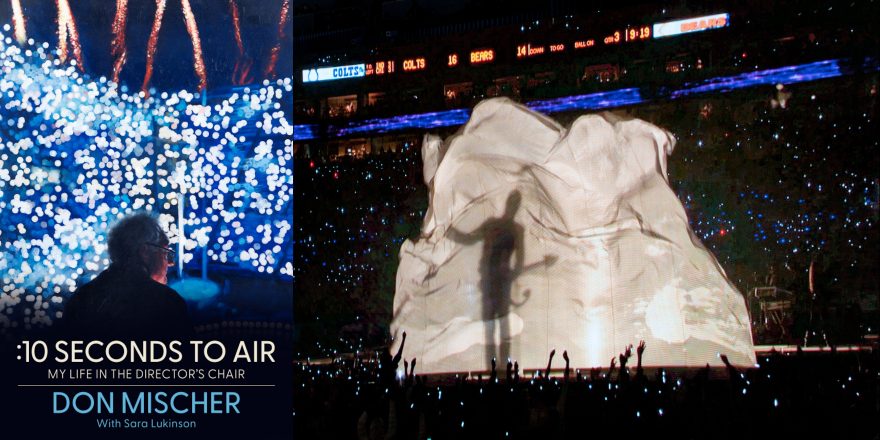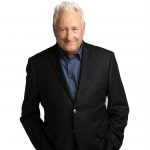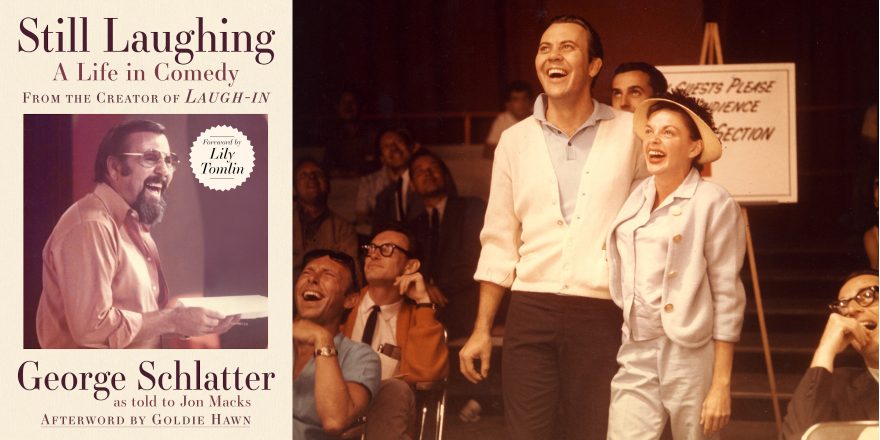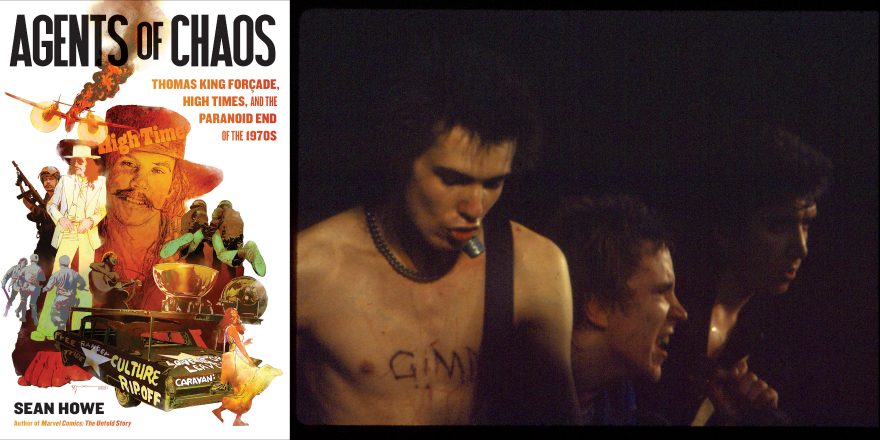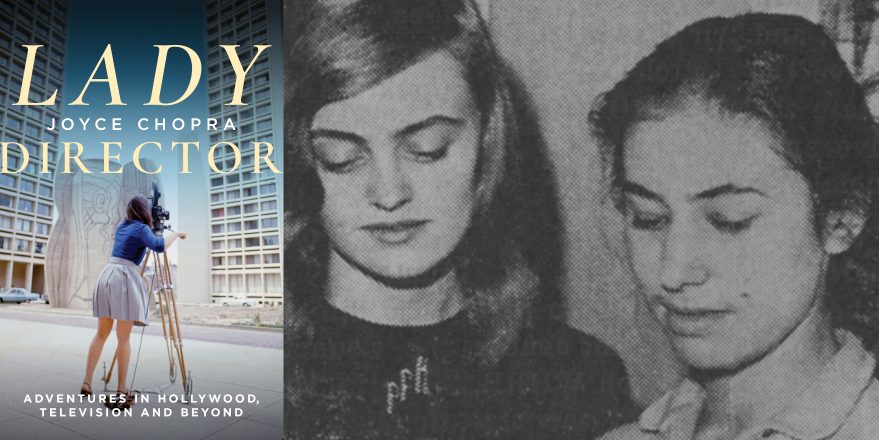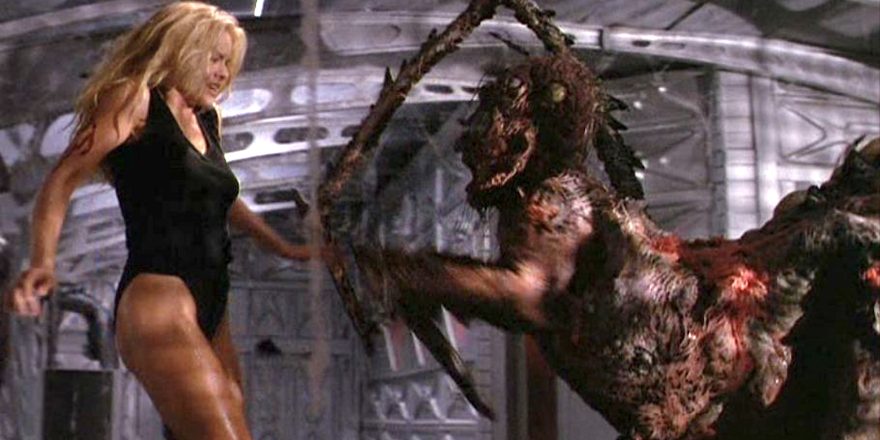The following is taken from :10 Seconds to Air: My Life in the Director’s Chair, the new memoir veteran Don Mischer, who is one of the most acclaimed and respected producer/directors ever to work in television. :10 Seconds to Air is out now and the excerpt below is reprinted here by permission of Don Mischer and Unnamed Press; all rights are reserved.
It had started raining by the time I got back to the hotel at 1 a.m. on Sunday morning, February, 2007. It was Super Bowl Sunday. We were in Miami working with Prince on the halftime show at Super Bowl XLI. I needed to sleep, but I couldn’t. Light rain was predicted for the game, and I was scared. Prince’s stage was shaped like his logo; it took 620 volunteers to roll out seventeen giant pieces of the stage onto the field and fit them together like a giant jigsaw puzzle. The surface of the stage was shiny mylar that was slippery to begin with, and when it got wet, it could be dangerous. Dolphin Stadium in Miami Gardens had no roof. Both the game and the halftime show were fully exposed to the elements.
My head was rattling with problems that rain could cause. For one thing, Prince was to play four live electric guitars. Would they short out? Would they stay in tune when sopping wet? The Twinz, Prince’s spectacular identical twin dancers, would be wearing stiletto heels that were eight inches high. What would happen if one of them fell and got injured? Would we stop and bring out a stretcher? Or would we barrel through with just one of the Twinz? How odd would that be?
My line of work is high risk. People who do what I do are always taking chances. Often on the night before a show, I think to myself, “You’ve been really lucky, man. You’ve had people jumping out of helicopters, flying on thin wires high above the Oscar audience at the Dolby Theater in Hollywood, and standing in very scary places— like on top of towering skinny buttes of red sandstone in Arizona’s Monument Valley — and so far, no one has ever fallen or suffered serious injury. Moreover, no one ever died! But sometimes I feel like I’ve been dodging bullets my whole career. What? Me worry? Well … it’s just part of the job.”
When I first met Prince at his house on Sierra Alta Way in Beverly Hills, I parked in his driveway, and he personally greeted me at the door. I was expecting his house to feel “rock and roll,” but what I saw was elegance and sophistication. Art and fresh flowers were everywhere. His logo, which was a “love symbol” mash-up of the gender symbols for a man and a woman, was embedded in his entryway with tiny gold and purple tiles. It was amazing. And just off the entryway there was a huge, fully equipped elevated sound stage with instruments set and ready to go on a moment’s notice, and state of the art recording, editing, and mixing gear. He kept two tech ops (operators) 24/7 at his house. If Prince had a creative idea in the middle of the night, it was, “Everybody up!”
He walked me to his dining room, and we sat down. He was soft spoken and a gentleman. He looked me in the eye and said, “We’ll be working together for months, and I want you to know that there is absolutely no alcohol or profanity in my presence.” A little surprised by his request, I respectfully nodded.
For Super Bowl XLI, his artistic objectives were different from any previous halftime artists, who always chose to sing only their own songs. Prince clearly wanted a great show more than just promoting his own songs. So, he included songs from Bob Dylan, Foo Fighters, Queen and John Fogerty, creating a unique, unpredictable show for a massive worldwide audience. When I pitched the Florida A&M marching band joining him on the field and suggested creating his silhouette against a billowing silk fabric, he liked those ideas, and we did them. We spent a lot of time thinking about pyrotechnics or “pyro” and decided to use it occasionally for accents, until the finale, when we would full-out blow the stadium apart.
We all moved to Miami a week before the game and rehearsed on the actual stage – assembled in a large tent next to the stadium – for five hours a day. We had only one rehearsal on the actual Dolphin Stadium turf, and that was Thursday night three days before the game. It didn’t go well. Prince was not happy. He couldn’t hear his voice fold back to him on the stage speakers. He had trouble singing in the right key and staying in tempo.
We met in his trailer, and I asked, “Why didn’t you just stop the rehearsal?”
He said, “I didn’t know I could do that.”
I was shocked and I felt I had dropped the ball. I should have discussed rehearsal objectives before we went out on the field. I said, “If you are bothered by something when we are rehearsing, we need to stop and fix it. That’s what rehearsals are for.” I continued, “You have to feel comfortable and confident when you’re performing for millions of people around the world.” I brought in our sound engineers. It was not a big deal and took no time to fix the fold back issue. Then we went back out on the field and spritzed water on the stage to see how slippery it got when wet. As expected, it was dangerously slippery. We all went home that night, concerned about safety.
Then, it was game day: Indianapolis Colts versus Chicago Bears. It was raining lightly, but the first half of the game went smoothly. At halftime, it was Colts 16 and Bears 14 as the players left the field. When the head referee signaled us that we now had control of the field, Gary Natoli, our lead stage manager, jumped into action. He had only six minutes and 40 seconds to roll out and assemble the seventeen huge pieces of Prince’s stage — complete with his band, lighting, wind machines, special effects, a couple of miles of audio cable, and a tiny dressing room for Prince under the stage, then bring 3,000 Prince fans onto the field, and finally, line up the Florida A&M Marching Band in the stadium tunnels. Our 620 volunteers had been rehearsing the stage roll out onto the field, assembly, sound and light checks, tear down, and roll off over and over at a nearby high school football field for a month. I’m convinced they were so familiar with the drill that they could have done it in a whiteout blizzard. So, as we were about to go on air, we were all set, and all seemed to be OK ….
Then, about 30 seconds before air, the heavens just opened, and a torrential rainstorm hit. Prince was now preset under the stage. I called him on my walkie, “Just want to give you a heads up … it’s really coming down now.”
Prince said to me, “Can you make it rain harder?” That amazed me.
He clearly saw the downpour as a personal challenge. It wasn’t going to stop him.
I said, “OK … go for it!”
Gregg Gelfand, my associate director, started counting down, “10 … 9 … 8 …” to air. I tried not to panic but I felt like the captain of an ocean liner just before he hits the iceberg.
We kicked off with a few seconds of Queen’s “We Will Rock You.” Then an explosion. Prince rose dramatically from center stage on an elevator lift called a “toaster” with “Let’s Go Crazy.” By the time we got 90 seconds into the show, by some miracle, the guitars were still working, the Twinz were still dancing, and rain was hitting the hot lights on and around the stage, creating an ethereal mist of smoke and steam drifting across the stage and into the crowd. Water droplets hitting the camera lenses created a surreal look of hexagonal twinkling stars. It was haunting. A look we could never have dreamed of—and all because of the heavy rain. Prince grabbed his doo-rag and threw it into the audience, allowing the water droplets to run down his face. Thrilled at what I was seeing, I yelled to several cameras, “Get me real tight close-ups!”
Suddenly, I realized that our biggest fear – the rain – had become a blessing – a magical act of nature that inspired Prince to deliver one of his best performances ever. If I ever needed proof that live television is unpredictable, that sometimes things do go wrong, this was the time. Instead, it was spectacular. And it kept getting better as Prince powered his way through John Fogarty’s “Proud Mary.” And then dramatically changed pace with Bob Dylan’s “All Along the Watchtower.” During “The Best of You” (Foo Fighters) we used six old prop airplane engines mounted flat into the stage to blow upward a 35-foot high silk fabric. It was soaking wet and much heavier than we wanted, but thankfully it rose. On it we projected a huge live silhouette of Prince playing his guitar behind it. Dave Grohl, the lead singer and guitarist for Foo Fighters, later said, “Having been a massive fan of Prince my whole life, I was flattered beyond words. What an honor to be covered by one of your heroes.”
I was later told that a lighting cable had been severed when the stage was being rolled out onto the field. The severed cable had controlled half of the stage lights. Tony Ward, head gaffer of our lighting crew, worked feverishly and unsuccessfully to fix it, and about a minute before air, he just gave up and stripped the insulation off of three copper wires, inserted them into a female plug, and held them together while standing next to the stage for 12 and a half minutes in the pouring rain. I’m thankful I didn’t know it at the time — there was enough stress as it was. But Tony Ward saved the show.
By the time we got to the finale, 85,000 people – soaking wet and bathed in purple light – were on their feet singing “Purple Rain” with Prince. It was magical. In the truck, Bruce Rodgers, who had designed and built the set, and fellow producer Glenn Weiss were standing behind me – mesmerized. How lucky could we get? On the last note of “Purple Rain,” I used a chopper high above Dolphin Stadium to shoot the extraordinary pyro finale which wrapped around the entire stadium.
Wow! The response was instant. Thirty seconds after going off the air, calls flooded into the truck from all around the country and the world – even from Australia and China, where it was 7 a.m. Monday morning. Prince had scored big time.
After coming down from the high, I took my wife, Suzan, my son, Charlie, and my daughter, Lilly, to visit Prince backstage. He and I were both relieved. We chatted for a bit and when we said goodbye, Prince glanced at me and then said to Suzan, “You’ve got a good one here.” As strange as it may sound, that made me feel validated by a genius artist I was both honored and proud to be working with. Prince put his heart and soul into that show. The New York Times said, “his performance last night at Super Bowl XLI will surely go down as one of the most thrilling halftime shows ever.”
And it has – to this day.
Featured image includes photo by Lorie Shaull via Flickr.



